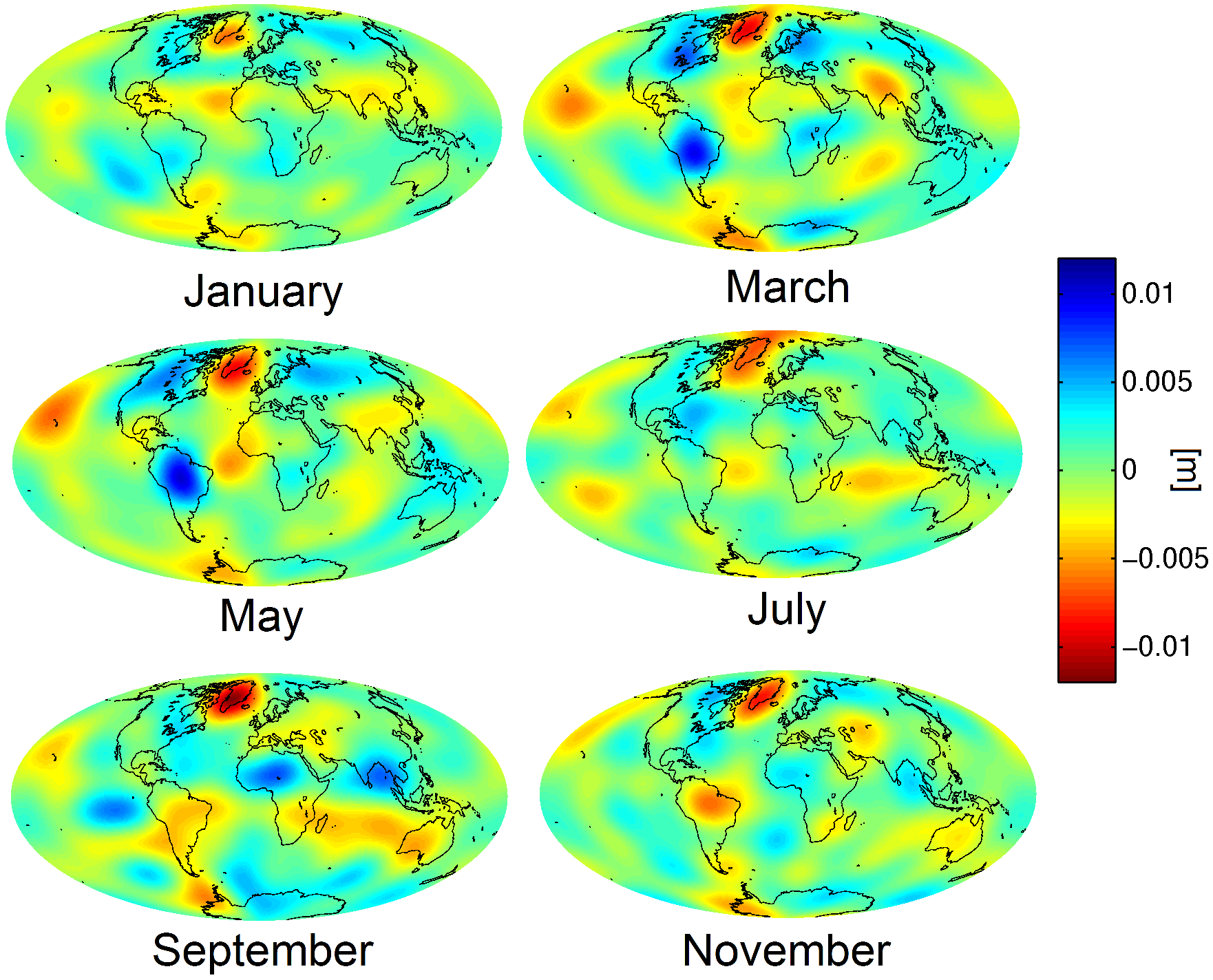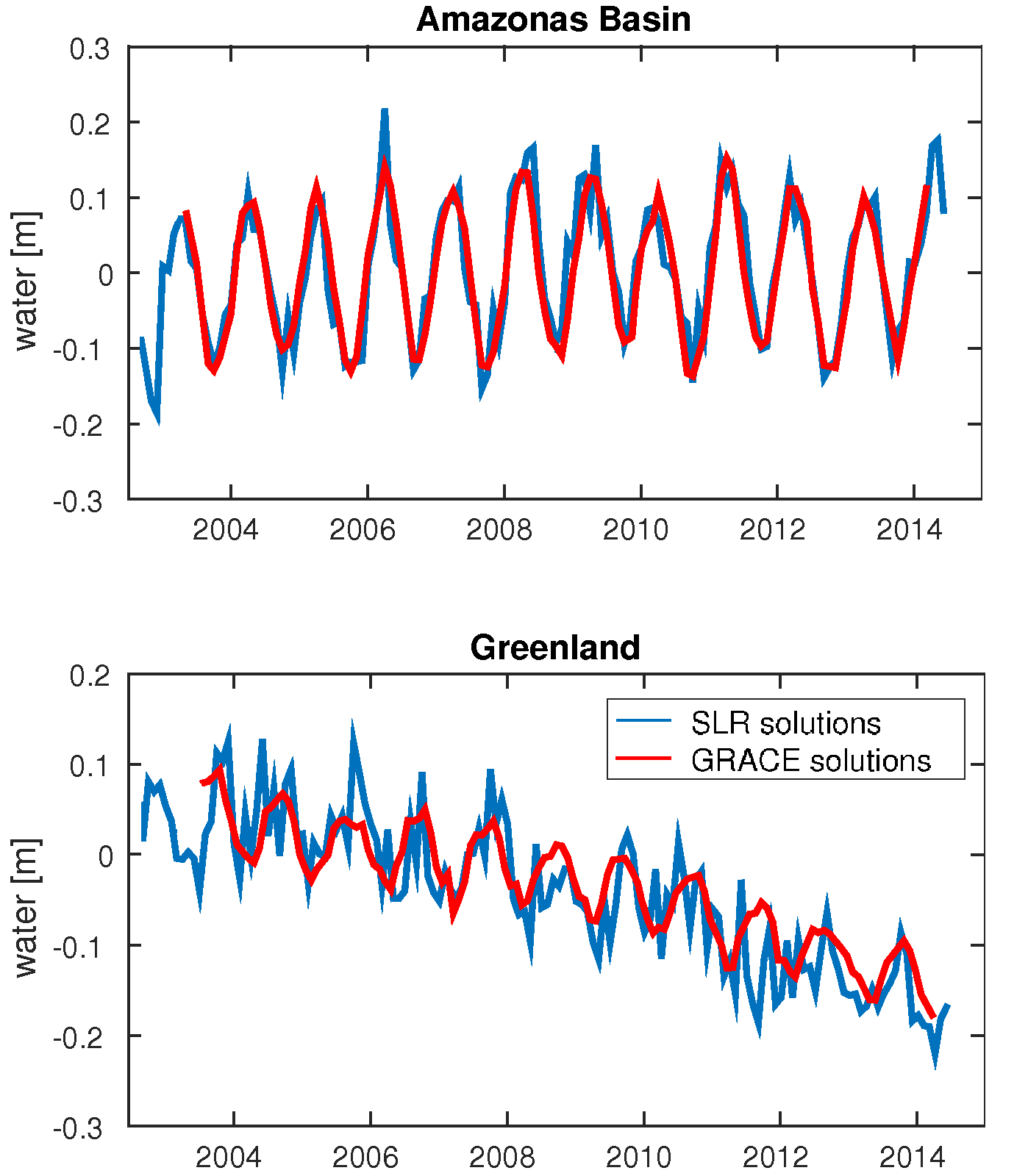The temporal variations of the Earth's gravity field provide information about the mass transport in the system Earth, i.e., about the relations between the mass redistribution in the atmosphere, oceans, land hydrology, and ice sheets. Satellite Laser Ranging (SLR) measurements to geodetic satellites have been delivering valuable information on the lowest-degree coefficients of the Earth's gravity field since 1975 and 1976, i.e., since the two SLR-dedicated spherical satellites Starlette and LAGEOS-1 were launched, respectively. Today, the Gravity Recovery And Climate Experiment (GRACE) mission is the key source of information for the temporal gravity field variations. The tandem GRACE-A/B satellites allow defining the mass variations with high spatial resolution and accuracy. The lowest-degree coefficients of the gravity field, however, are still better defined by the geodetic SLR satellites because the K-band GRACE observations are nearly insensitive to the geocenter variations due to their interferometric measurement type. This leads to a degraded C20 coefficient (i.e. the Earth’s dynamical flattening) due to long-period signals such as the S2 and S1 tidal aliases with GRACE orbits. Therefore, SLR to geodetic satellites is the best technique to determine C20.
The GRACE mission, launched in 2002, was initially designed for five years. Even after more than thirteen years the GRACE satellites still provide precise data. There is, however, a serious risk that the mission may be decommissioned at any time. The GRACE Follow-On Mission (the successor of the GRACE mission) is planned to be launched in 2017, implying that most likely there will be a gap between the missions. Thus, the potential contribution of SLR to fill this gap in recovering the time variable low-degree coefficients shall be assessed.
We simultaneously estimate gravity field coefficients up to degree/order 10/10, Earth rotation parameters, station coordinates, satellite orbits, and range biases from combined SLR solutions incorporating eight geodetic satellites (LAGEOS-1/2, Starlette, Stella, AJISAI, Blits, Larets, LARES) as well as Beacon-C. The monthly gravity field solutions are based on 10-day arcs of LAGEOS satellites and 1-day arcs of low orbiting SLR satellites. Estimating short arcs for low orbiting satellites avoids the accumulation of orbit errors and their propagation into the estimated gravity field parameters. The gravity field parameters are obtained in a three-step procedure. In the first step, 1-day normal equations are generated individually for each low orbiting satellite and 10-day normal equations are generated for LAGEOS-1/2 using screened observations. In the second step, 10-day solutions are generated by combining SLR observations to all satellites; all common parameters except for orbital parameters, which are pre-eliminated before stacking and implicitly remain in the resulting normal equation, are stacked. At this stage, the continuity of ERPs is enforced at day boundaries and the pseudo-stochastic pulses are constrained before stacking. Finally, monthly solutions are generated by stacking all parameters from three 10-day normal equations and by imposing minimum constraints on the core stations in the network, on ERPs, and on gravity field parameters.
 Mean monthly gravity field variations from SLR solutions up to d/o 10/10 w.r.t. EGM2008, no filtering applied from the period 2003-2014.
Mean monthly gravity field variations from SLR solutions up to d/o 10/10 w.r.t. EGM2008, no filtering applied from the period 2003-2014.
The figure above shows that the most significant large-scale geoid deformations, e.g., in Greenland, Amazonia, North America, and Southeast Asia can be recovered by the SLR solutions. On the other hand, the smaller geoid deformations can be recovered by SLR only to a limited extent. The SLR solutions are noisy which is visible especially over the oceans and the SLR-derived amplitudes of geoid deformations are typically smaller by 10% compared to the GRACE results. The most pronounced temporal geoid deformations in the Amazon Basin agree remarkably well between SLR and GRACE solutions:
 Temporal changes of the Earth’s gravity field in terms of water height derived from SLR and GRACE data for the Amazon Basin and for Greenland using coefficients up to d/o 6/6.
Temporal changes of the Earth’s gravity field in terms of water height derived from SLR and GRACE data for the Amazon Basin and for Greenland using coefficients up to d/o 6/6.
SLR is also capable of recovering the secular gravity changes in Greenland caused by the accelerated ice mass depletion. SLR has, thus, a large potential in filling the gap between GRACE and GRACE Follow-On missions for studying large-scale gravity variations on the one hand, and in multi-decanal studies of gravity change by incorporating historical SLR data on the other hand. The consistent and homogeneous series of SLR observations are indispensable in the studies of the temporal change of the Earth’s potential which may serve as an indication of the climate change.
 Secular changes in geoid heights from GRACE (up to d/o 60/60) and SLR (up to d/o 10/10) solutions in the period 2003-2013.
Secular changes in geoid heights from GRACE (up to d/o 60/60) and SLR (up to d/o 10/10) solutions in the period 2003-2013.
The main structures are well comparable in both plots. Some of the smaller geoid changes such as the post-glacial rebound in Scandinavia could not be properly resolved by SLR due to opposite trends in neighboring areas. On the other hand, not only the largest secular changes in Greenland and Antarctica agree well between SLR and GRACE but also some of the smaller deformations in Amazonia and Africa show similar. To some extent, the signals related to the Patagonian glaciers melting or to droughts in California can also be recovered by SLR. We conclude that the secular geoid changes based on SLR and GRACE data agree very well. SLR-derived gravity field models have a limited spatial resolution as compared to the GRACE solutions, though.
Related references providing further details and results.
Meyer, U., Jäggi, A., (2014). AIUB-RL02 monthly gravity field solutions from GRACE kinematic orbits and range rate observations. GRACE Science Team Meeting 2014, GFZ Potsdam.
Sośnica, K., Jäggi, A., Thaller, D., Beutler G., Dach, R. (2014). Contribution of Starlette, Stella, and AJISAI to the SLR-derived global reference frame. J Geod 88(8): 789-804, doi: 10.1007/s00190-014-0722-z.
Sośnica, K., Jäggi, A., Meyer, U., Thaller, D., Beutler G., Arnold, D., Dach, R. (2015a). Time variable Earth's gravity field from SLR satellites. J Geod 89(10): 945-960, doi: 10.1007/s00190-015-0825-1.
Sośnica, K., Jäggi, A., Thaller, D., Dach, R., Meyer, U., (2015b). Earth Rotation and Gravity Field Parameters from Satellite Laser Ranging. Proceedings of the 19th International Laser Ranging Workshop, NASA GSFC, October 27-31, 2014, Annapolis, US.